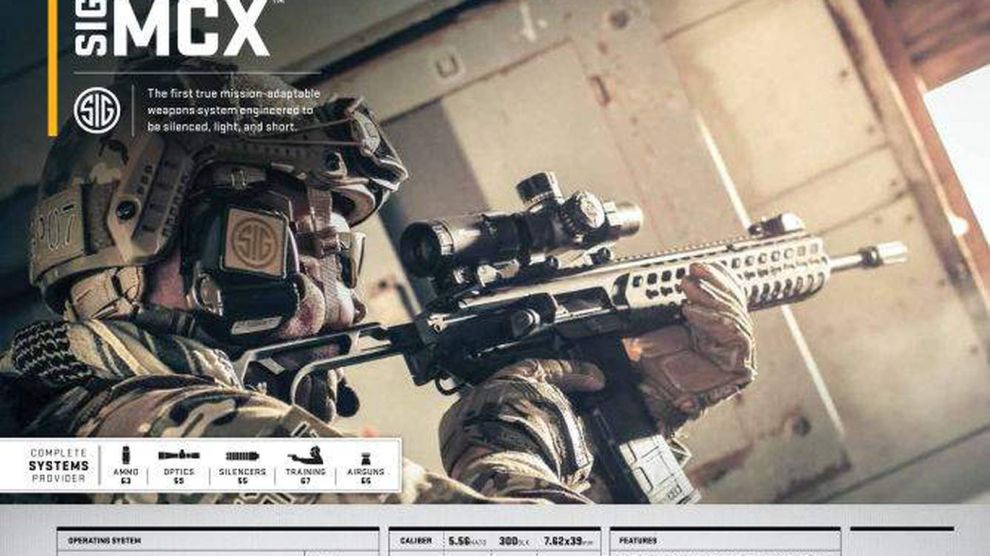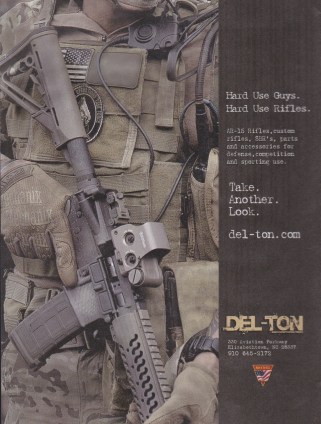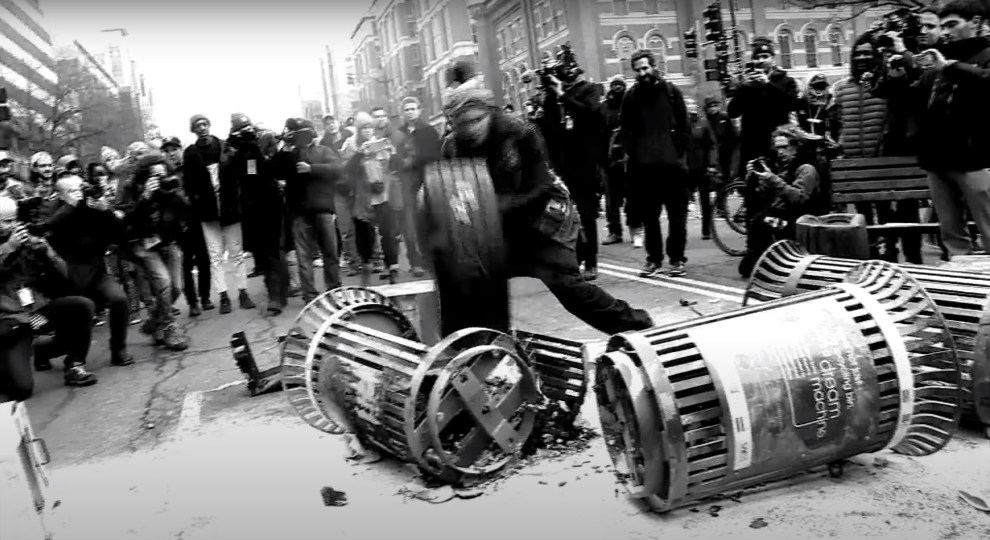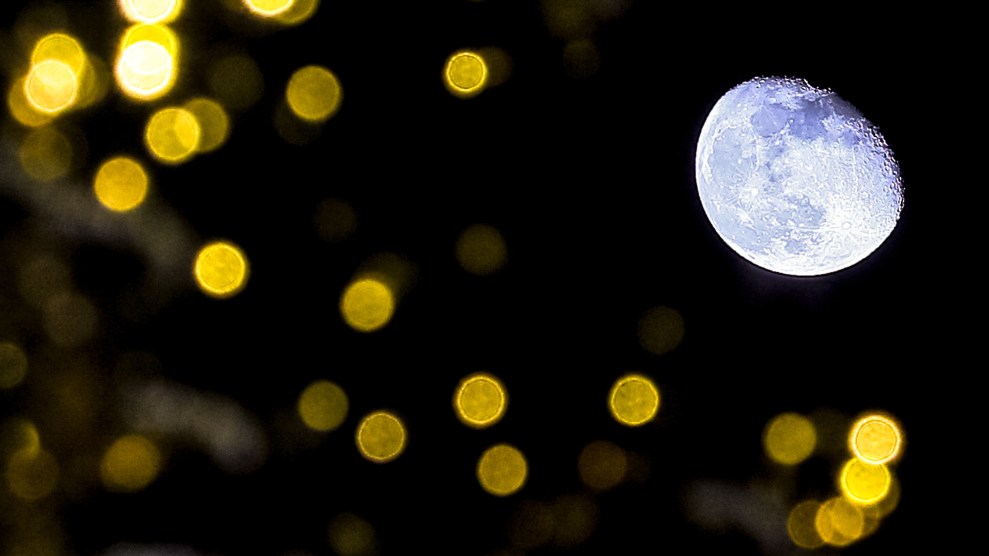
Stephanie Keith/ZUMA
“The criminal element is out in our community. We do see that on the news every single day.” That’s Ed O’Carroll talking. He’s appearing at the outset of a promotional video for the National Rifle Association’s “award-winning crime prevention program,” Refuse to be a Victim. Geared toward helping people identify potential threats to their safety—from would-be burglars to rapists—the program has offered thousands of seminars nationwide since 1993. As they tell it, Refuse to be a Victim was founded at the request of NRA members and staffers who were concerned about the uptick in violent crime in America, particularly against women. Though both men and women attend the program seminars, the gendered threat is central to the promotional video. Clips that could be ripped from the editing bays of Law & Order: Special Victims Unit show white women being trailed by shadowy figures, dressed in black and presumably looking to do them harm. The implicit suggestion of racial difference can hardly be viewed as innocent, and indeed, the overwhelming whiteness of the video is startling. When O’Carroll makes repeated reference to “our community,” it is not a stretch to assume that few people of color reside there.
By participating in one of the hundreds of training sessions the program puts on every year, you can learn about threats that go far beyond walking alone through dark alleys: Don’t keep your insurance information in your glove compartment (your valet might photograph it and burglarize your home while you’re away). Make sure to cut wide corners when out walking (someone might be waiting to ambush you around the hedge). And never, ever do laundry late at night in a communal laundry room (you might get raped, murdered, and thrown into the trash compactor). Indeed, and despite FBI statistics charting the significant decline in violent crime, the program stresses just how unsafe you truly are. “According to the FBI, in 2016, there were an estimated 1,248,185 violent crimes reported to law enforcement. That’s one violent crime every 25 seconds!”
Refusing to be a victim requires a new mindset altogether, one that is constantly surveying situations, guarding encounters, and never trusting strangers. That was the lesson I drew from my own three-hour training seminar, which took place early one morning in a converted factory building in upstate New York. “Seminar” might be overshooting the mark. It was a private class with one of the program’s certified instructors, a retired NYPD officer who gleefully recounted his own exodus from the metropolis to the south. He had initially started a private security contracting business after leaving the force but found his true calling in teaching for the NRA, and now here he was, in a room decorated in gun-rights slogans and 9/11 memorabilia, urging me to channel my inner mama bear.
When I asked if it would ever be advisable to hitch a ride to a gas station in the event my car broke down, my instructor indicated that the police would probably never find my body in the rural area where we live. He recommended that I keep a handgun locked in a safe in my child’s bedroom, so I could run there in the event of a home invasion, never mind of course that my 12-gauge would serve me far better in such a scenario—shotguns are a lot more effective for those who don’t practice regularly with a pistol. The message was one of both empowerment and fragility, security and precarity. Victimhood in such a framing is not a matter of chance but a consequence of making the wrong choice. It is the moralist’s position taken to its most grotesque conclusion.
While the appeal to gun ownership is never far below the surface, Refuse to be a Victim does not train students to use firearms or review the laws of open carry. It is more accurately described as a crash-course in threat assessment, in which civilians are taught to think like law enforcement personnel. As Jennifer Carson has chronicled in Citizen Protectors, the National Rifle Association has long encouraged its members to regard themselves in such terms. American gun owners like George Zimmerman clearly see themselves as sovereign agents, tasked with keeping themselves and their families safe amid the perceived absence or withdrawal of the state. The provision of security, which in the liberal political tradition forms the basis for a government’s legitimacy, is here devolved to individuals instead, who—as in Zimmerman’s case—serve as police, judge, and executioner. In Carson’s formulation, “everyday people are increasingly expected to take on—and are celebrated for embracing—social functions formally or typically addressed by the state by turning, instead, to the marketplace.”
In August, an everyday person named Kyle Rittenhouse, all of 17 years old, shot three protesters in Kenosha, Wisconsin, two of them fatally. For all the associations of American gun culture with libertarianism, the tyranny against which Americans like Rittenhouse feel they must arm themselves is certainly not the state. In a video taken shortly before the shooting, a cop tosses Rittenhouse a water bottle and thanks him for being there—a partner in the effort to maintain a particular type of law and order. White vigilantism now routinely accompanies protests for racial justice, with its proponents—often armed—assuming the role of watchmen dutifully standing guard over our nation’s entrenched hierarchies. It’s not some abstract commitment to personal liberty that drives gun owners like Rittenhouse to regard themselves as auxiliary agents of state violence. It’s racism, a project on which they and the state are eager to cooperate.
After a brief period of separation, the gun industry and the government are partners once more. All it took was a global war, a manufactured border crisis, and a national uprising for Black liberation.
The largest expansion of the domestic arms market in recorded history has occurred since the turn of the 21st century. In 2002 the total number of firearm background checks clocked in at a measly 8.45 million; that figure had ballooned to over 28 million in 2019. Similarly, gun manufacturing in American has grown apace, jumping from 2.9 million total firearms produced in 2001 to a peak of 11.5 million in 2016. More recently, and against the backdrop of the uprising that began after the killing of George Floyd in Minneapolis, the FBI conducted over 3.9 million firearm background checks in June 2020 alone, an all-time high, and another 3.6 million in July. Taken together with data from March, in which COVID anxieties drove 3.7 million checks, 2020 is proving to be a most excellent year for gun manufacturers and dealers. Nearly 23 million checks were executed from January to July alone, a number that exceeds the total annual checks for all years prior to 2014.
These statistics are staggering on their own, but all the more so if you consider them alongside two other data points. The first is a landmark survey conducted in 2016 by researchers at Harvard and Northwestern, which found that 63 percent of gun owners identified “protection against people” as their primary rationale for ownership. Notably, fear of others far outstripped hunting or recreation—a complete reversal from the last time such data was systematically collected, in 1994. Second, and perhaps more puzzling given these findings, the gun boom has taken place over a period of time in which violent crime has fallen precipitously. According to FBI statistics, the property crime rate declined 42 percent from 1998 to 2017, as did rates of burglary (down 50 percent), larceny (down 38 percent), and aggravated assault (down 31 percent). In empirical terms, we are safer than ever, though you would never know it from our gun habits.
Of course perception is not reality, and polling data has regularly shown that a majority of Americans believe that crime is getting worse nationwide. Yet the data also reveals that this has not always been the case. While 89 percent of respondents in 1992 felt this was true, this figure had fallen to 41 percent in 2001—more or less tracking the contemporaneous decline in violent crime—before shooting up again to 62 percent in 2002. Since then, the percentage of respondents who believe crime is worsening has mostly fluctuated between 65 and 70 percent, even as actual crime rates continue to fall.
According to the National Shooting Sports Foundation, the chief firearms industry trade association, this remarkable market growth “has been driven by an unprecedented number of Americans choosing to exercise their fundamental right to keep and bear arms.” Explanations of this kind paint a picture of people coming to the light, suddenly waking up to the sanctity of the Second Amendment. But the rapid uptick in gun sales since the turn of the century, and the documented link between gun ownership and fear, points to a darker side of an American gun boom that has emerged alongside the War on Terror. When it comes to the domestic firearms market, it turns out that fear sells better than anything else. And in a stroke of almost providential luck for the industry, Americans have become experts at selling fear.
In this context, the 2020 surge in gun sales was all-too predictable. The uprising that began after Floyd’s casual murder at the hands of Minneapolis police was just the latest in a string of events that underscored the salience of racial fears to the American gun market. The election of Barack Obama, for example, sent firearm sales and concealed handgun permits to an all-time high. Ferguson served as a siren song for white gun owners, as well—a detail that Jonathan Metzl unearthed while doing research for Dying of Whiteness, which traces how the politics of racism exacerbate public health crises for white Americans. As he said stated in an interview: “A number of people I talked to in my book basically said, I’m getting this gun because of Ferguson. These were people who lived 300 miles from Ferguson, in entirely white areas of rural America. When I tried to pin them down about it, they would say, ‘This could happen anywhere. I have to protect myself and my property.’”
While Black Americans have pride of place in the American racist’s pantheon of Feared Others, they do not reside there alone. Otherness is a capacious and ever-expanding category. For instance, when KelTec released an advertisement in 2019 for its KS7 12-gauge shotgun, “MI CASA NO ES SU CASA” was the chosen tagline. With its bullpup design and long pistol grip, it is marketed chiefly as a tool for home defense. The advertisement’s language suggests that KelTec customers have a particular type of intruder in mind when they envision themselves heroically defending their homes and families, and that he has come from south of the border. Never mind that immigrants are no more likely to commit crimes than native-born Americans, according to data assembled by the Cato Institute, or that the inverse in fact appears to be true. We like to imagine our assailants coming from without, which is why we hear few eulogies for the thousands of American women killed by their current or former romantic partners, but the tragic example of Mollie Tibbetts became a political football in the anti-immigration game.

Back at home from my Refuse to be a Victim training session and newly aware of threats that even my anxious mind could not have conjured up, I was struck by how little my course had in common with the firearm classes that have long been the bread and butter of the NRA’s educational programs. Those classes offer the illusion of mastery over potential threats. This was something else—a program designed to cultivate a persistent fear of the unknown. If anything, in its insistence on a heightened watchfulness, it is a close cousin of New York City’s famed “If you see something, say something” campaign. Indeed, my trainer was a retired counterterrorism officer, and variations of the city’s well-known tagline were everywhere.So, too, is the specter of jihad still evoked alongside the anti-Black and anti-immigrant discourses of fear. There is a particular irony here, given that mass shootings by ISIS supporters—such as those perpetrated at a San Bernardino, California, office complex and the Pulse nightclub in Orlando—have effectively blurred the sacrosanct division between insider and outsider violence, “tragedy” and “terrorism.” This distinction helps us make sense of the otherwise contradictory fact that a country obsessed with national security regards mass shootings by homegrown, predominantly white men as the natural order of the universe about which we can do very little. Yet appeals to Islamic terrorism perform a certain type of political work in the gun world, as when President Trump said of the 2015 ISIS attacks in Paris, “If there was one gun being carried by one person on the other side, it very well could have been a whole different result.” The likelihood that a civilian carrying a pistol could take out numerous assailants armed with automatic rifles is extremely unlikely, of course, but fantasies of Citizen Rambo are a formidable opponent. Such invocations of heroism inevitably position gun owners as allies and auxiliaries to police and counterterrorism teams, who—from water-boarding prisoners to shooting unarmed Black men—can seemingly do no wrong.
Thinking about American gun culture in the shadow of 9/11 offers a different way to make sense of the seemingly contradictory data points surveyed above, wherein the decline in actual crime rates has not forestalled a growing sense of insecurity. The fear that another terrorist attack could be merely a moment away—striking anyone and anywhere—has reshaped our sensibilities in profound ways. For nearly two decades Americans have been tasked with the job of constant vigilance, in which we are called upon to survey situations, assess risk, report suspicious activity, and even play the part of superheroes in stopping would-be assailants—to do, in other words, just what I was instructed to do in my Refuse to be a Victim training. We have been enlisted as soldiers in the security agenda and charged with the defense of the homeland.
The power of this sentiment has not been lost on gun marketers, who routinely create advertisements that play on the blurred lines between civilians and military personnel. Featuring combat scenes and soldiers in fatigues, the implicit suggestion is that you, too, can have a professional-grade death tool at your disposal. If it’s good enough for our boys in Afghanistan, it’s surely good enough for your front lawn.

Similarly, companies like Smith & Wesson boast that their “modern sporting rifles are specifically designed to satisfy the functionality and reliability needs of global military, law enforcement, and security personnel,” while Shooting Illustrated praised KelTec’s KS7 as “lighter and shorter than many submachine guns,” noting that it “delivers firepower on part [sic] with the much longer and heavier riot guns of conventional design.” It is just what you need to support the forces of law and order.

Such language and imagery reveal that the war abroad and violence at home are more deeply intertwined than we usually recognize. The effects of this merger are evident not merely in the militarization of police forces as a result of the government’s 1033 program—wherein the War on Terror’s arsenal makes a second appearance on city streets—but in the attitudes of everyday people. Is it really that shocking that, after years of imbibing this lethal brew, individuals like Mark and Patricia McCloskey stand ready to guard their McMansions from Black Lives Matter protesters with his-and-hers firearms? That Kyle Rittenhouse felt it was his personal duty to protect the city of Kenosha? Though they may not volunteer for service in Afghanistan, it turns out that many Americans are eager to play soldier in their own backyards.
In an infamous 2017 video set against the backdrop of the protests that accompanied Donald Trump’s inauguration, NRA spokeswoman Dana Loesch argued that guns are the only logical way to restrain the lawlessness of “the resistance.” “They use their media to assassinate real news,” she said. “They use their schools to teach children that their president is another Hitler. They use their movie stars and singers and comedy shows and award shows to repeat their narrative over and over again. And then they use their ex-president to endorse the resistance, all to make them march, make them protest, make them scream racism and sexism and xenophobia and homophobia, to smash windows, burn cars, shut down interstates and airports, bully and terrorize the law abiding, until the only option left is for the police to do their jobs and stop the madness.” Loesch concluded the video by calling upon NRA supporters “to fight this violence of lies with the clenched fist of truth,” explicitly aligning the group with the police. The war, she argued, is already here.

Though liberals often imagine gun owners as delusional libertarians assembling arsenals to defend against government tyranny—cue Wayne LaPierre’s rant about “jack-booted government thugs” out to “break in our doors, seize our guns, destroy our property, and even injure or kill us”—Loesch’s message reflected a very different message, one that the Trump administration is now playing at full blast. Our brave men and women in uniform need you, citizen soldier, to join them in protecting America from its foes – domestic and foreign. It is the natural outgrowth of the War on Terror’s culture of constant vigilance, turned onto the Others within. Forget guarding against government tyranny. Today’s NRA is happy to serve as its midwife.
This is not, moreover, an unprecedented alliance. The seeming contradiction of libertarian gun owners joining forces with the feds dissolves if you remember that the two sides have historically worked in concert in service of white supremacy—from the slave patrols to Westward expansion and beyond. Surely a country that deputized individuals to hunt the Dakota people, offering up to $200 per scalp to those not enrolled in government patrols, cannot be too precious about the boundary between civilians and law enforcement. Backlit by this history, the recent period of separation—which began with the NRA’s reactionary realignment in the 1970s and culminated with the 1993 Brady Bill and the 10-year ban on assault weapons enacted in 1994—looks more like a brief anomaly. And the present, in which a gun market structured by racist fears and turbocharged by the War on Terror stands at the ready to “protect” certain people from Black liberation, likewise looks like a continuation of one of America’s oldest public-private partnerships.
This reunion has revealed something essential about the American gun experience: The oft-mentioned tyranny being opposed by gun owners is really just the sense that the wrong people, the people against whom American whiteness defines itself, are encroaching on the privileges and prerogatives of whiteness; from the start such “tyranny” was associated with the protection and advancement of the rights of Black Americans. This is necessary background to understand why, as Mother Jones‘ Matt Cohen has noted, the NRA has been utterly silent as of late about a “mass mobilization of militarized police and unknown federal agents in cities across the country to shut down largely peaceful mass demonstrations of people exercising their constitutional rights”—in other words, the very jackboots they profess to be concerned about. Turns out the gun industry is happy to side with the feds so long as it is Black and Brown people who appear in the crosshairs.
All this suggests that when Donald Trump tweeted his infamous threat last May—“When the looting starts, the shooting starts”—he was not just referencing federal or state law enforcement. Indeed, Rittenhouse would have been justified in thinking the president was speaking directly to him. During the first presidential debate that left commentators aghast, Trump did directly address the forces of white supremacy. Inviting the Proud Boys—who rolled into Portland after federal troops departed—to “stand by,” Trump underscored just how compatible a certain brand of white vigilantism is with the current exercise of state power. Any attempt to understand this fascistic alliance requires confronting the unholy matrix of militarism aboard and racism at home, and the way that nearly two decades of constant vigilance have helped create actual vigilantes. And we better act fast. As Dana Loesch suggests, the war is already here.
A version of this essay appeared in the March+April 2020 print issue of Mother Jones.
Suzanne Schneider is deputy director and core faculty at the Brooklyn Institute for Social Research. Her new book, The Apocalypse and the End of History, will be released by Verso Books in 2021.















